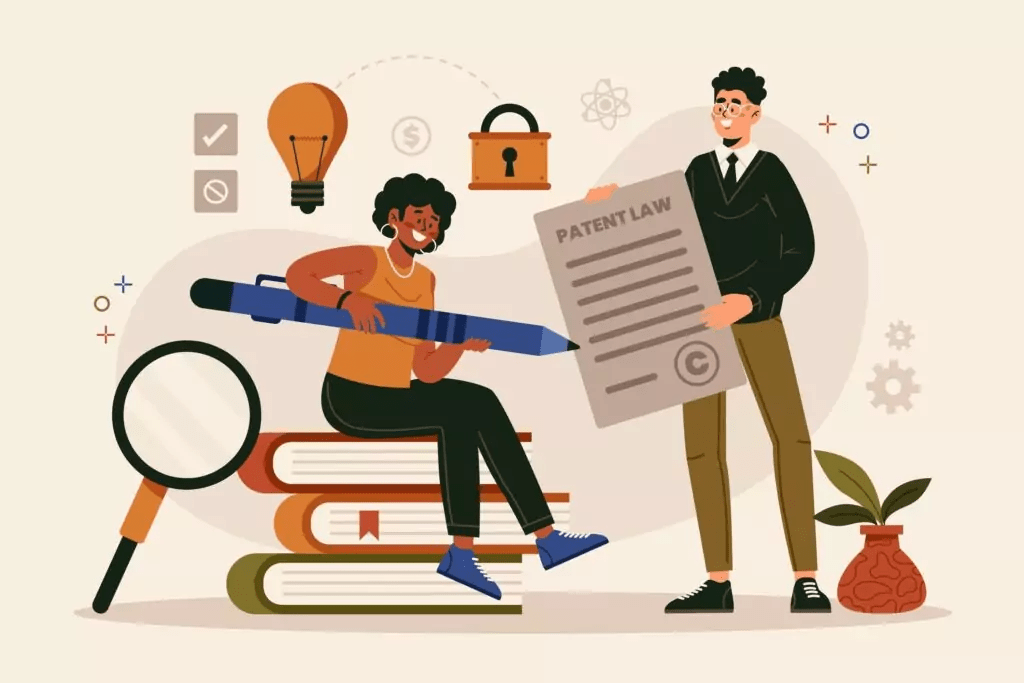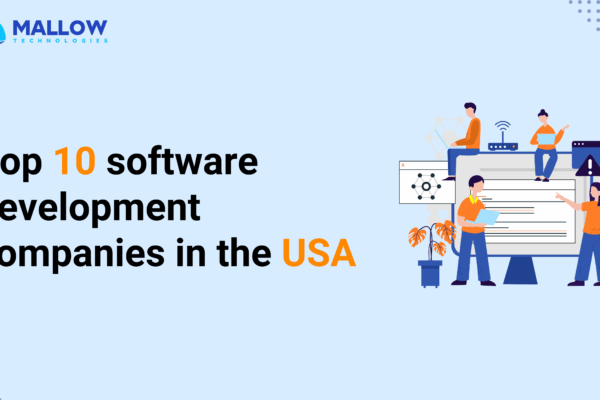In today’s digital landscape, intellectual property has become a critical asset for businesses, especially in software and application development. When organizations collaborate with external teams to bring new ideas to life, protecting intellectual property rights becomes essential. With rapid technological advancements and the ease of sharing information, safeguarding your IP can be complex without the right approach.
At Mallow, transparency and open communication are central to how we work. With more than a decade of experience as a custom software development company, we focus on building collaborative relationships rooted in trust. We understand the value of intellectual property and take deliberate steps to protect and respect our clients’ ideas, ensuring they remain secure throughout the development process.
By reading this article, you will gain a clear understanding of how IP ownership helps reduce risk and protects your innovations and investments, giving you greater confidence as you build and scale your software solutions.
What is Intellectual property (IP)?
Intellectual property plays a critical role in software development, where innovation and creativity drive business value. In today’s digital environment, protecting software-based ideas, inventions, and investments is essential for maintaining a competitive advantage and securing long-term returns.
According to the World Intellectual Property Organization, global patent filings grew by 1.7 percent in 2022, reaching 3.46 million applications. Trademark filings declined to 15.5 million, while industrial design filings fell to just under 1.5 million. Applications for utility models increased by 2.9 percent to 3 million. These figures highlight the growing focus on protecting technological innovation despite shifts in other IP categories. (Source: WIPO)
Understanding intellectual property helps application owners protect their innovations through patents. Patents grant exclusive rights that prevent others from making, using, or selling an invention without permission. Securing a patent for a unique feature or functionality strengthens market positioning, attracts investors, and reduces the risk of competitors copying the innovation.

For example, imagine a food delivery company that develops a unique algorithm to optimize delivery routes in real time. By patenting this innovation, the company gains exclusive rights to the technology. This prevents competitors from replicating the algorithm and helps establish a strong position in the market.
Trademarks are equally important for protecting an application’s brand identity and reputation. A trademark can include a name, logo, or slogan that distinguishes a product or service from others. Registering a trademark prevents competitors from using similar branding that could confuse users. This protection helps preserve brand value, customer trust, and long-term loyalty.
For instance, when a food delivery company registers its name and logo as trademarks, it ensures that no competing service can use similar branding. This allows users to easily recognize the application and associate it with reliability and quality.
Copyrights protect the original creative elements of an application, including source code, user interfaces, graphics, and multimedia content. Copyright ownership prevents unauthorized copying, distribution, or modification of these assets. Understanding copyright laws enables application owners to enforce their rights and protect their original work.
If you want to explore practical approaches to securing intellectual property, you can refer to detailed guides available on platforms like Medium that outline effective IP protection strategies.
Trade secrets also represent valuable intellectual property for application owners. These may include proprietary algorithms, internal processes, or unique business methods. Trade secrets provide a competitive advantage as long as they remain confidential. By using strong security controls and confidentiality agreements, businesses can protect these assets from unauthorized disclosure or misuse.
What are some other IP-related considerations to discuss with your application development team?
Open Source Software
When using open-source software in an application, it is important to understand the licenses that govern it. Each open-source license comes with its own requirements and conditions. These may include providing proper attribution or sharing modifications under the same license.
For example, consider a web application that uses the popular open-source JavaScript library jQuery to simplify development. jQuery is released under the MIT license, which is a permissive open-source license. This license allows you to use, modify, and distribute the library, even in commercial applications, with minimal restrictions.
However, the MIT license requires that the original copyright notice and permission notice be included in all copies or substantial portions of the software. In this case, you must ensure that your web application includes the appropriate attribution to jQuery. This can be done by adding the copyright and permission notice to relevant files or documentation. Following these steps ensures compliance with the license terms while benefiting from open-source software.
Licensing and Distribution
For commercial applications, developers may choose to licence their software to third parties or distribute it through various channels. Understanding licensing agreements, royalty structures, and distribution rights is crucial in protecting IP and ensuring proper compensation for the use of the software.
International IP Protection
Intellectual property protection extends beyond national borders. Considering international IP laws and seeking appropriate protections, such as patents or trademarks, in different countries may be necessary, especially if the application has a global reach or target audience.
Enforcement and Litigation
In cases of IP infringement, developers may need to enforce their rights through legal means. This can involve litigation, cease and desist letters, negotiation, or seeking settlements. Understanding the legal options available and working with intellectual property attorneys can help protect and defend IP assets effectively.
Why should I own the IP of my application?
1. Legal protection

When you own the IP rights, you have legal protection against unauthorised use, reproduction, distribution, or modification of your software. It allows you to enforce your rights and take legal action against any infringement or misuse of your application.
2. Commercial value
Owning the IP gives you the ability to monetise your software application. You can licence it to others, sell it, or use it as a core asset for your business. By retaining the IP, you have control over how your software is used and can negotiate favourable deals with partners or investors.
3. Competitive advantage
In today’s technology-driven world, innovation is key to staying ahead of the competition. By owning the IP, you have exclusive rights to your software’s unique features and functionalities. It prevents others from copying or replicating your ideas, giving you a competitive edge in the market.
For example, let’s consider a social media platform that devises a one-of-a-kind algorithm for personalised content recommendations. By securing a patent for this algorithm, they effectively prevent competitors from copying their technology. As a result, they gain a competitive edge and are able to attract a larger user base to their platform.
4. Future growth and expansion
As your software application evolves, owning the IP allows you to adapt, enhance, and expand it as needed. You can release updates, create new versions, or integrate it with other technologies without any restrictions or dependencies on third parties.

People communicating via social media flat vector illustration. Business team using mobile phones, laptops, tablets for networking and chatting. Digital technology and conversation concept
Let us consider a software company that owns the IP for a cloud-based project management application. They continuously enhance and release updates to meet evolving customer needs. Having full control over their IP enables them to adapt and expand the software without relying on third parties.
5. Brand protection
IP ownership includes protecting your software application’s name, logo, and branding elements. By owning these rights, you can safeguard your brand’s reputation and prevent others from using similar branding that may confuse customers or dilute your market presence.
For example, let us consider a software startup registering a trademark for its logo and name. This protects their brand identity and reputation from being exploited or confused with similar competitors. It allows them to establish a strong market presence and maintain customer loyalty.
6. Partnership and investment opportunities
Investors and potential partners often look for assurances that the IP of a software application is properly protected and owned by the entity they are considering working with. Owning the IP enhances your credibility, making it easier to attract investors, secure partnerships, or enter licensing agreements.
Let us assume a healthcare tech company secures several patents for their innovative telemedicine platform. This ownership of IP enhances their credibility and attracts potential investors and strategic partners who value the protected technology. It opens doors for collaborations, investments, and licensing agreements.
7. To ensure complete ownership
Lack of ownership and control over your application can also present challenges when it comes to exit strategies. For example, if you decide to sell your application or merge with another company, owning the IP provides a valuable asset. Potential acquirers or partners may be more interested in acquiring a product with IP rights, as it provides a competitive advantage and long-term value.
8. Protect yourself from vulnerability to competitors
Without proper knowledge of their IP, business owners cannot protect their innovative ideas, technologies, or unique features from being copied or replicated by others. Competitors can exploit this lack of IP protection and potentially create similar applications that imitate or surpass the original. This puts the application owners at a disadvantage in terms of market differentiation and may result in a loss of market share, customer trust, and potential revenue.
How can IP be effectively managed when working with an outsourced application development team?
Managing intellectual property with application development companies requires clear agreements that define ownership, usage rights, and responsibilities from the outset. Well-structured contracts help avoid disputes and ensure that all parties understand how intellectual property will be handled throughout the development process.
An IP agreement typically outlines key elements such as intellectual property ownership, moral rights, confidentiality obligations, terms and termination clauses, infringement handling, dispute resolution, governing law and jurisdiction, and the effective date of the agreement. It should also clearly define the scope of work and the services included, ensuring there is no ambiguity about deliverables and ownership.
Non-disclosure agreements are commonly used to protect sensitive information shared during development. These agreements help safeguard business ideas, technical details, and proprietary data from unauthorized disclosure.
It is also important to conduct due diligence when selecting a development partner. Ensure the company respects copyright laws and does not use or reproduce third-party intellectual property without proper authorization.
Effective IP management protects the interests of both parties and supports a transparent, secure, and successful collaboration in application development.
What are some typical steps to be taken for owning the IP?
Take the necessary steps to protect your software application by registering for copyrights, and trademarks, or patents, depending on the nature of your IP. Safeguarding your IP can provide legal recourse in case of infringement or unauthorised use. Below mentioned is a checklist that will turn out handy for you when you initiate the process of IP-related works for your application.
- Conduct a thorough IP audit. Assess all aspects of your application, including software code, algorithms, designs, branding elements, and trade secrets. Identify the intellectual property that needs protection.
- Research existing IP. Conduct comprehensive searches to ensure your application does not infringe upon existing patents, trademarks, or copyrights. This minimises the risk of legal conflicts and allows you to make necessary adjustments if any conflicts arise.
- File for patents. Identify novel and inventive aspects of your application and file for patents to protect them. Work with a qualified patent attorney to navigate the complex patent application process.
- Register trademarks. Register your application’s name, logo, and branding elements as trademarks to prevent others from using similar marks that may cause confusion in the market. Consult with a trademark attorney to ensure proper registration and enforcement.
- Secure copyrights. Apply for copyrights to protect your application’s source code, graphics, and other creative elements. Although copyright protection exists automatically, formal registration strengthens your legal position in case of infringement.
- Implement confidentiality measures. Safeguard trade secrets and confidential information by implementing non-disclosure agreements (NDAs) with employees, contractors, and partners. This ensures that valuable information remains protected.
- Draft robust contracts. Use well-drafted contracts, such as software development agreements and licensing agreements, to clearly define ownership rights, usage permissions, and restrictions related to your application. Seek legal counsel to draft or review these contracts.
- Monitor and enforce your IP rights. Regularly monitor the market for potential infringement. Actively enforce your IP rights by sending cease and desist letters, pursuing legal actions if necessary, and keeping records of your enforcement efforts.
- Educate your team. Train your employees and stakeholders about the importance of IP protection and the proper handling of sensitive information. Foster a culture that values and respects intellectual property rights.
- Stay updated. Stay informed about changes in IP laws and regulations that may impact your application’s protection. Regularly review and update your IP strategy to adapt to emerging challenges and opportunities.
Still, wondering where you need to take the next step? Get in touch with our team.
Your queries, our answers
IT outsourcing refers to hiring a third-party service provider to handle software development tasks, allowing businesses to access external talent and resources for specific projects or ongoing development needs.
- A team of developers is assigned exclusively to your project, providing specialized expertise and full focus on your needs.
- It offers high flexibility, full commitment, and alignment with your project goals.
- Outsourcing for specific projects with clear deliverables, timelines, and objectives, based on a fixed scope.
- It provides a defined project scope and milestones, effective use of resources, and focused expertise.
- Supplementing your in-house team with external IT experts to fill skill gaps or increase capacity for specific tasks or projects.
- It gives immediate access to specialized skills, increased flexibility, and enhanced project capabilities without long-term commitment.
- Onshore: Outsourcing to a company in your home country.
- Offshore: Outsourcing to a company in a distant country, often for cost savings.
- Nearshore: Outsourcing to a neighboring or nearby country, offering similar time zones and easier communication.
Mallow offers a blend of technical expertise, proven methodologies, and flexible engagement models to deliver high-quality software solutions tailored to your needs, with a strong focus on communication and project management.
Common risks include:
- Communication barriers (especially in offshore outsourcing)
- Time zone differences
- Potential quality issues
- Data security and confidentiality concerns.
These risks can be mitigated by choosing the right partner and implementing clear communication and security protocols.
To explore these risks in detail and discover strategies for effective mitigation, consider seeking additional insights on managing challenges in outsourcing.
If you choose software development outsourcing, you will have the following benefits:
- Access to a diverse global talent pool
- Significant cost reduction
- Accelerated time-to-market
- Ability to concentrate on core business functions
- Increased scalability and adaptability
To learn more about these benefits and how they can impact your business strategy, check out our detailed insights.
Choosing the right outsourcing partner is a critical decision that can significantly impact the success of your project. To ensure you make an informed choice, consider the following key factors:
- Experience and portfolio
- Technical expertise and industry knowledge
- Client references and reviews
- Communication and collaboration processes
- Security measures and data protection policies
- Cost structure and flexibility
Check out our article to explore these factors in detail and understand the steps to effectively select your ideal development team.
Getting started with mallow involves 3 simple steps :
- Contact us with your project requirements
- We will discuss your needs, provide a proposal, and define the scope of work
- Once the contract is signed, we’ll kick off the project with a dedicated team
We ensure transparency through:
- Detailed project plans and timelines
- Clear communication channels
- Regular reporting and progress updates
- Access to project management tools and dashboards
Mallow ensures effective communication and collaboration across different time zones through:
- Structured Communication: Utilizing clear channels like regular video meetings, emails, and project management tools to keep all stakeholders informed and engaged.
- Flexible Scheduling: Arranging meetings and updates at times convenient for all parties, ensuring overlap for real-time discussions.
- Comprehensive Documentation: Providing detailed project documentation and status reports to ensure everyone is aligned, regardless of time zone.
- Dedicated Points of Contact: Assigning project managers and team leads to facilitate seamless communication and address any issues promptly.
Author
SathishPrabhu
Sathish is an accomplished Project Manager at Mallow, leveraging his exceptional business analysis skills to drive success. With over 8 years of experience in the field, he brings a wealth of expertise to his role, consistently delivering outstanding results. Known for his meticulous attention to detail and strategic thinking, Sathish has successfully spearheaded numerous projects, ensuring timely completion and exceeding client expectations. Outside of work, he cherishes his time with family, often seen embarking on exciting travels together.



